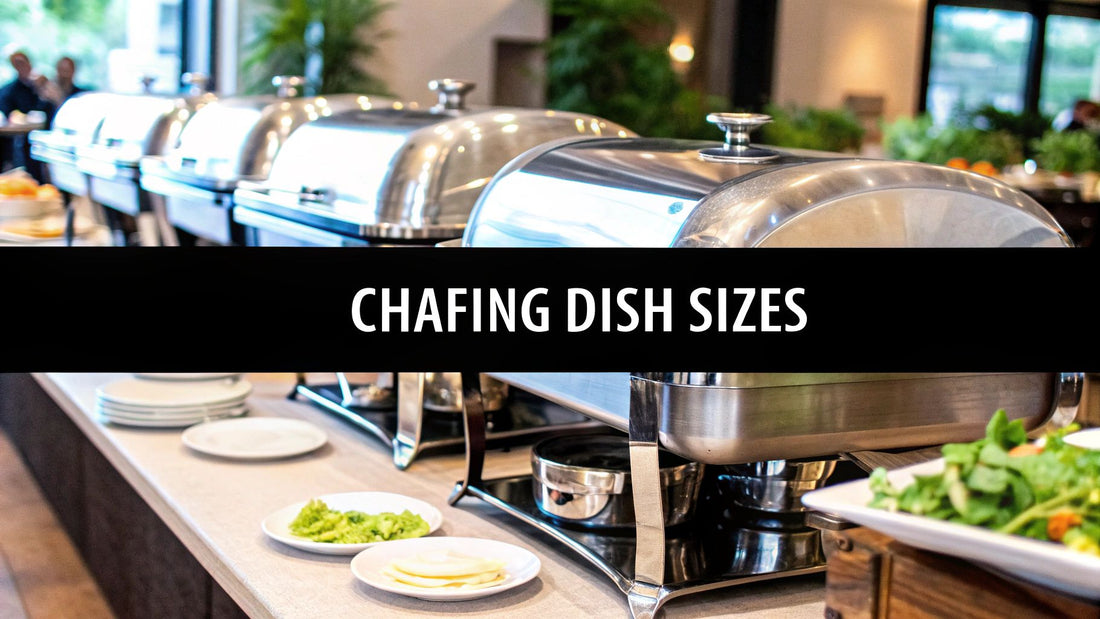
A Chef's Guide to Chafing Dish Sizes: Discover Deals, News & Trends
Share
Choosing the right chafing dish is the secret weapon behind any flawless buffet line. It’s a detail that might seem small, but it makes all the difference. The industry really boils it down to a few key players: the full-size (holding 8-9 quarts), the versatile half-size (4-5 quarts), and various round models (4-7 quarts).
Knowing the strengths of each one is the first real step to mastering efficient service and creating a food presentation that truly wows your guests. This guide not only breaks down the sizes but also helps you stay informed on the latest industry trends and exclusive deals, ensuring your restaurant is always ahead of the curve.
Mastering Chafing Dish Sizes for Flawless Service
A successful buffet isn’t just about the food—it’s about the entire experience. It's how the food is held, how it looks, and how it’s served. In that equation, the chafing dish is your most important tool, acting as the final handshake between your kitchen and the guest's plate.
Think of your chafing dishes like a chef’s knife set. You have your workhorse chef's knife, your nimble paring knife, and your specialized slicer. You wouldn't use a tiny paring knife to carve a prime rib, and for the same reason, you shouldn’t cram a high-volume entrée meant for a wedding into a small, round chafer. The right size chafer keeps food at that perfect, appetizing temperature and makes your entire buffet line look and feel professional.
Why Size Selection Is So Crucial
Picking the right chafing dish size goes way beyond just making the buffet table look good. It's a decision that directly impacts your bottom line and how smoothly your event runs.
- Portion Control: The correct pan size helps you nail your portions. This means less food waste at the end of the night, which is money straight back into your pocket.
- Service Efficiency: Using a chafer that’s properly sized for the dish and the crowd means your staff isn't constantly running back to the kitchen for refills. It keeps the line moving and the guests happy.
- Food Quality: A chafer that's filled to the right level holds its temperature far more consistently. This is key to preventing food from drying out or, even worse, dropping into that dreaded temperature danger zone.
When you master the standard chafing dish sizes, you stop just serving food and start engineering a guest experience. It’s what allows you to build a buffet that’s as smart and functional as it is beautiful.
This guide will walk you through the industry standards, starting with the workhorse full-size chafer and moving on to the more specialized options. Once you get these fundamentals down, you’ll be able to make purchasing decisions that elevate your entire catering game and take advantage of the best deals on restaurant equipment.
The Full-Size Chafer: Your Buffet Workhorse
When you think of a classic buffet line—maybe at a wedding or a big corporate lunch—what's the first thing that pops into your head? It’s probably that big, rectangular, shiny chafing dish. That's no accident. Its commanding presence and hefty capacity make it the undisputed champion for any high-volume event. This is the main stage for your headliner dishes, from savory roasted chicken to a creamy pasta primavera.
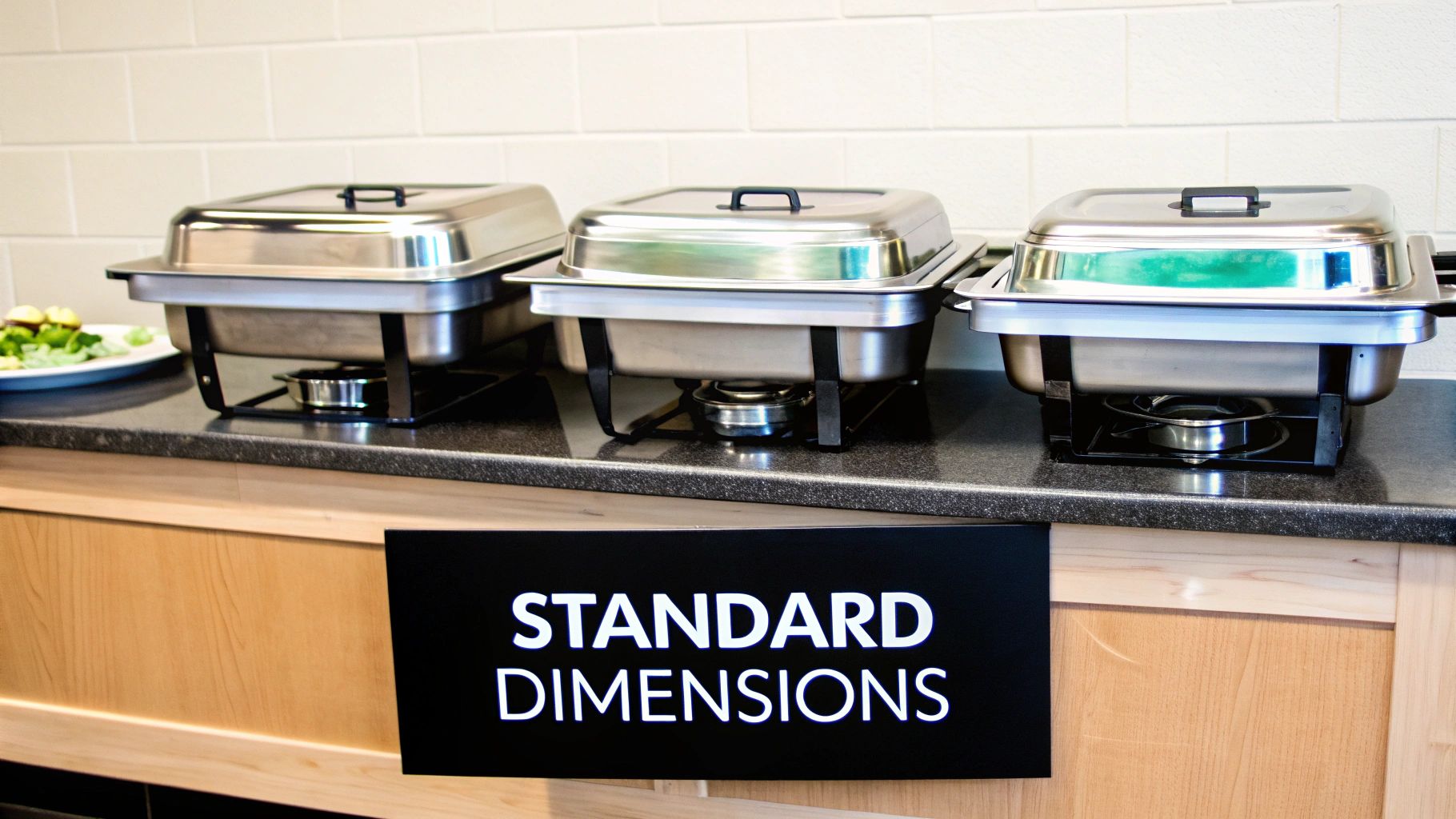
Holding a standard 8 to 9 quarts, the full-size chafer is built to feed a crowd without missing a beat. That capacity isn't just a random number; it hits the sweet spot between serving volume and heat retention, keeping big batches of food at a safe and appetizing temperature. It’s this reliability that has made it such a staple in the foodservice world.
The global demand for these essential tools is massive, with the chafing dish market valued at around USD 875.6 million. This industry trend shows just how crucial they are for hotels, catering companies, and restaurants everywhere. And right at the heart of that market is the full-size model, prized for its sheer utility.
Figuring Out Servings and Portions
One of the biggest anxieties for any chef or event manager is running out of food. It's the stuff of nightmares. Thankfully, the 8-quart capacity of a full-size chafer gives you a solid, reliable baseline to plan your portions.
Here’s a simple rule of thumb I’ve always used to guide planning:
- Main Entrees: For hearty main courses like chicken, beef, or a rich pasta, a full-size chafer will comfortably serve around 25 to 35 guests.
- Popular Sides: When it comes to popular side dishes—think roasted potatoes or a vegetable medley—you can stretch that to 35 and 45 people because the portions are naturally a bit smaller.
A quick pro-tip: always consider your menu's context. If you’re offering a wide variety of entrees, each chafer will serve more people since guests will sample a little of everything. On the flip side, with fewer options, people tend to take larger portions, so you’ll want to plan on the lower end of that serving estimate.
Unlocking Versatility with Pan Combinations
Now, here’s where the full-size chafer really shows its brilliance: its modular design. The frame isn't just a holder for one giant food pan. Think of it as a versatile platform you can adapt to fit whatever your menu calls for, letting you maximize every single inch of your buffet table.
For example, you can take a single full-size chafer frame and drop in two half-size food pans side-by-side. Just like that, you’ve turned a one-dish warmer into a two-dish station. It’s perfect for serving things that just belong together, like pulled pork and macaroni and cheese, from a single heat source. This kind of flexibility is a game-changer for creating dynamic, space-saving buffet setups and is a key feature of many food warmers for table service. You can even get creative and use three third-size pans to offer a trio of sauces or toppings, all within the footprint of one chafer.
Using Half-Size and Round Chafers Strategically
Think of your buffet line like a well-cast movie. The full-size chafers might be the headliners, holding the main courses, but it's the supporting cast that truly makes the production a hit. This is where half-size and round chafers come in. They’re the specialists that bring variety, visual flair, and smart organization to your food display. When you learn how to use these smaller chafing dish sizes effectively, you’re not just serving food—you're creating a better, more engaging experience for your guests.
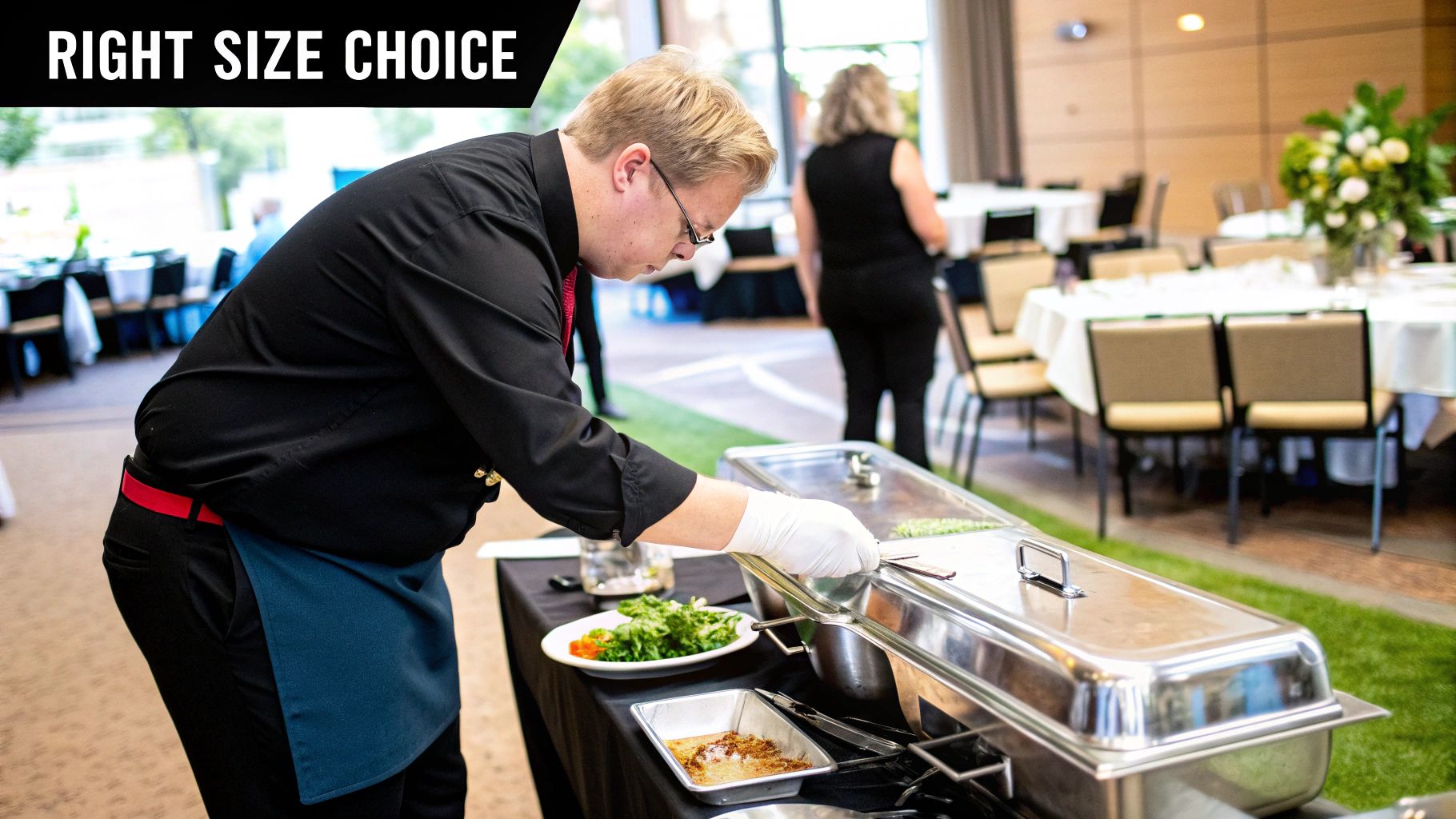
Holding a practical 4 to 5 quarts, half-size chafers are workhorses for all your sides, appetizers, and even desserts. Their smaller footprint is their superpower. It lets you offer a wider selection of items without making the serving table feel cramped or overwhelming. They are perfect for deconstructing a main dish, like separating toppings for a taco bar or offering a few different vegetable options side-by-side.
The Role of Half-Size Chafers
Mixing and matching chafing dish sizes does more than just save space; it creates a visual hierarchy that guides your guests. It's an unspoken cue, telling them which dishes are the main event and which are the accompaniments. This kind of thoughtful layout helps with portion control and keeps the line moving smoothly.
Imagine placing a full-size chafer of grilled chicken in the center, then flanking it with two half-size chafers—one with roasted asparagus and the other with a wild rice pilaf. It looks clean, professional, and is incredibly practical for serving. This principle of strategic placement is crucial whether you're using classic Sterno-fueled warmers or setting up a modern station. Our guide on selecting a food warmer table dives deeper into how different equipment sizes can really optimize your entire setup.
Adding Elegance with Round Chafers
While rectangular pans are all about efficiency, round chafing dishes are about making a statement. They break up the straight lines of a typical buffet, adding a touch of elegance that naturally draws the eye. Usually holding between 4 and 7 quarts, their real value is in presentation.
A round chafer is your go-to for menu items where appearance is just as important as taste. Use it to showcase creamy soups, signature sauces, or a premium dish like seafood paella.
The curved shape is also inherently better for serving anything that needs to be scooped or ladled. It’s simply a more graceful way to serve liquids compared to a sharp-cornered pan. A round chafer acts as a focal point, signaling to guests that whatever is inside is special.
As the industry evolves, so do the tools. Take the electric chafing dish market, for example. In North America, these electric models are often designed on a larger scale, sometimes ranging from 10 to 20 liters, to handle the demands of high-volume buffets. Keeping an eye on these equipment trends can give your business a competitive edge. By combining the straightforward utility of half-size models with the sophisticated look of round chafers, you can build a buffet that runs like a well-oiled machine and looks absolutely fantastic.
How Food Pan Sizes Create a Versatile Buffet
The real magic of a flexible, efficient buffet isn't owning a dozen different chafing dishes. It's all about understanding the modular system of food pans that fit inside them. This is the secret weapon that lets you adapt a single full-size chafer for a whole range of dishes, making the most of your space and menu.
This system, known worldwide as the Gastronorm (GN) standard, is a lifesaver for chefs and caterers because it guarantees pans from different brands will fit together perfectly. Think of a full-size chafer frame as your blank canvas—it's a standardized space you can fill in all sorts of creative ways to meet the needs of any event.
Unlocking Modularity with Standard Pan Sizes
The brilliance of the GN system is in its simple, fractional sizing. A standard full-size chafer is built to hold one full-size (GN 1/1) food pan. But its true potential shines when you start mixing and matching smaller pans.
You can instantly swap out that single large pan for:
- Two half-size (GN 1/2) pans: This is the classic setup for a main and a side, like serving barbecue chicken right next to baked beans, all kept warm by a single heat source.
- Three third-size (GN 1/3) pans: Perfect for when you need to offer a trio of options. Think taco bar toppings, a flight of different sauces, or a variety of small appetizers.
This modular design lets you offer more variety without crowding your buffet line with extra gear. It's a foundational strategy for anyone thinking about opening a buffet restaurant, as it has a direct impact on both your presentation and your workflow. With a simple adapter bar, you can securely combine these pans to build a custom layout for any menu.
The infographic below gives a great visual breakdown of how chafing dish sizes relate to serving capacity and the types of events they're best suited for.
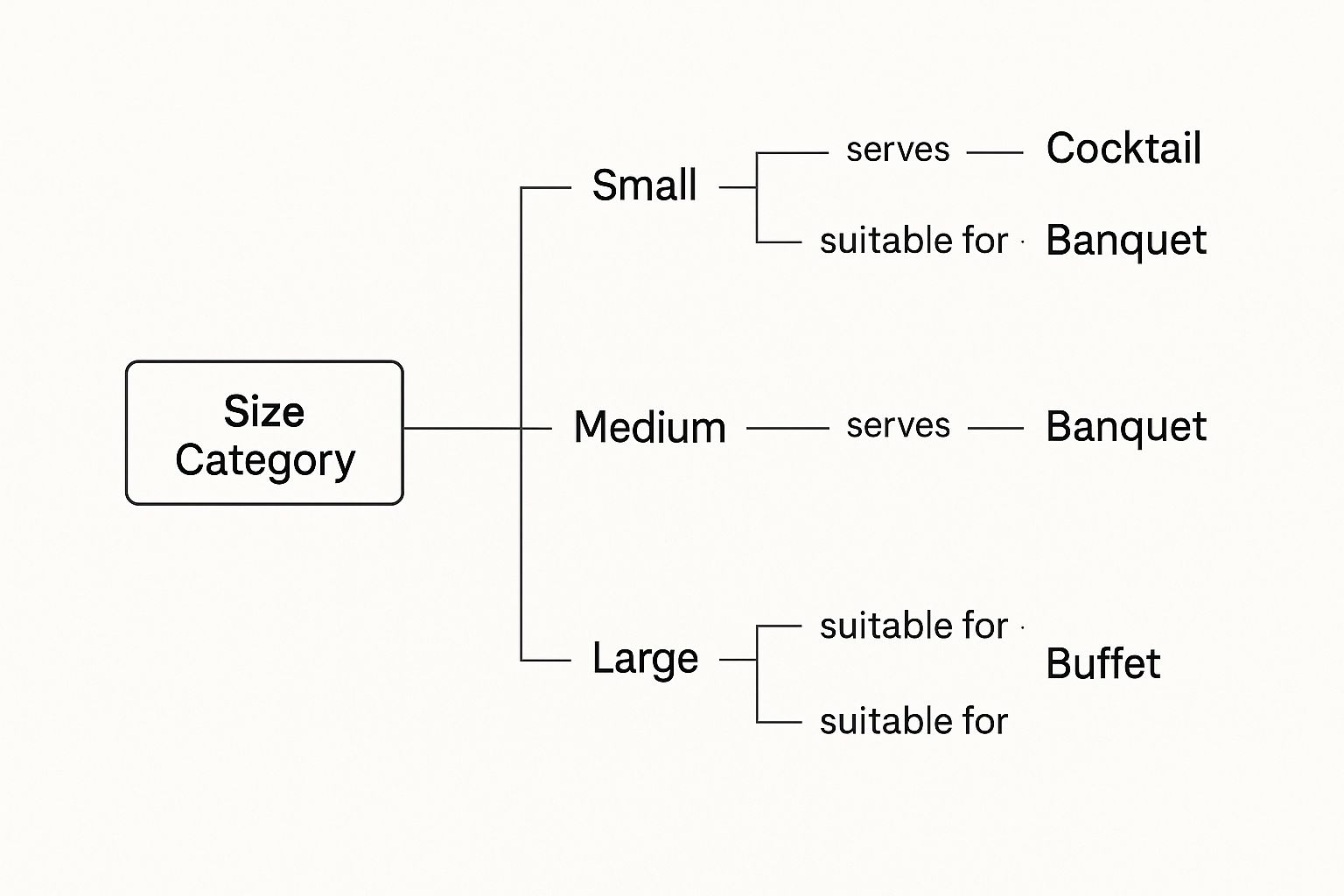
As you can see, the bigger chafers are your workhorses for large-scale events, while the smaller pans bring the versatility you need for more intimate gatherings or banquets with a diverse menu.
The Critical Role of Pan Depth
Beyond just length and width, the depth of your food pan is what truly dictates its volume and how many people it can serve. A shallow pan might be great for presentation and preventing delicate foods from getting crushed, but for a big crowd, you'll need a deeper pan to hold enough food.
Standard pan depths usually come in three main sizes:
- 2.5 inches: A very common depth that’s ideal for most entrees and sides.
- 4 inches: This gives you a significant boost in volume for popular, high-demand dishes.
- 6 inches: The go-to for deep dishes like lasagna or for holding bulk items at very large events.
By mastering the art of combining different pan sizes and depths, you gain complete control over your buffet. It allows you to perfectly match your food volume to your guest count, which means less waste and a serving line that runs like a well-oiled machine from beginning to end.
Putting It All Together: Matching Chafers to Your Menu and Event
Knowing the specs of each pan is just the start. The real skill comes in mixing and matching them to fit your specific menu and the unique flow of your event. Let's move from theory to practice and walk through a couple of real-world scenarios to see how this works on the ground.
Every event has its own rhythm. A quick corporate breakfast has a totally different vibe—and different needs—than a long, leisurely wedding reception.
Scenario 1: The Corporate Breakfast for 50
When you're feeding 50 people at a corporate breakfast, speed and variety are everything. These guests are usually on a tight schedule, so the line has to move quickly and the options need to be clear.
The best approach here is to use a mix of smaller pans. This lets you offer several different dishes without creating a massive, sprawling buffet line.
- One full-size chafer with two half-pans: This is your workhorse. Drop in two half-pans side-by-side to serve your main hot items, like scrambled eggs and bacon.
- Two separate half-size chafers: Use these for the supporting cast. One can hold breakfast potatoes while the other keeps a batch of pancakes or French toast perfectly warm.
This setup gives you four distinct hot options in a very small footprint. It keeps the line moving, prevents logjams, and makes for a much smoother experience for everyone.
Scenario 2: The Wedding Buffet for 150
A wedding buffet for 150 guests is a completely different ballgame. We're talking higher volume, a more relaxed pace, and a bigger focus on presentation. This is where your full-size chafers really get to shine, supported by smaller pans for all the sides and specialty dishes.
For any restaurant or caterer looking to grow, mastering the logistics for big events like this is a key part of maximizing catering sales.
A well-planned buffet should tell a story. Use your biggest chafers for the main courses to create an obvious starting point. From there, arrange the smaller pans with sides and salads to guide guests down the table in a natural, intuitive flow.
Here’s a solid equipment list for a wedding of this size:
- Three full-size chafers: These are for your headliners—think roasted chicken, sliced beef, and a vegetarian pasta.
- Four half-size chafers: Perfect for holding large quantities of your main side dishes, like roasted vegetables, mashed potatoes, or rice pilaf.
- Two round chafers: These add a touch of class. They’re great for things that need a more elegant presentation, like a signature soup or a creamy sauce for the main course.
This arrangement gives you plenty of food on the line, so your team isn't constantly running back to the kitchen for refills. It also creates a beautiful, professional display that guests will appreciate.
Remember, a standard 7-quart chafer usually needs one or two cans of chafing fuel, and each can lasts about two hours. You'll need to factor fuel management into your timeline to make sure the hot food stays hot from the first guest to the last.
Frequently Asked Questions About Chafing Dishes
Even after you've got the basics down, real-world questions always pop up when you're in the thick of event planning. Getting these details right can be the difference between a smooth service and a major headache. Let's tackle some of the most common questions I hear from chefs and caterers.
Think of this as your quick-reference guide for those last-minute decisions that can save you time, food, and frustration.
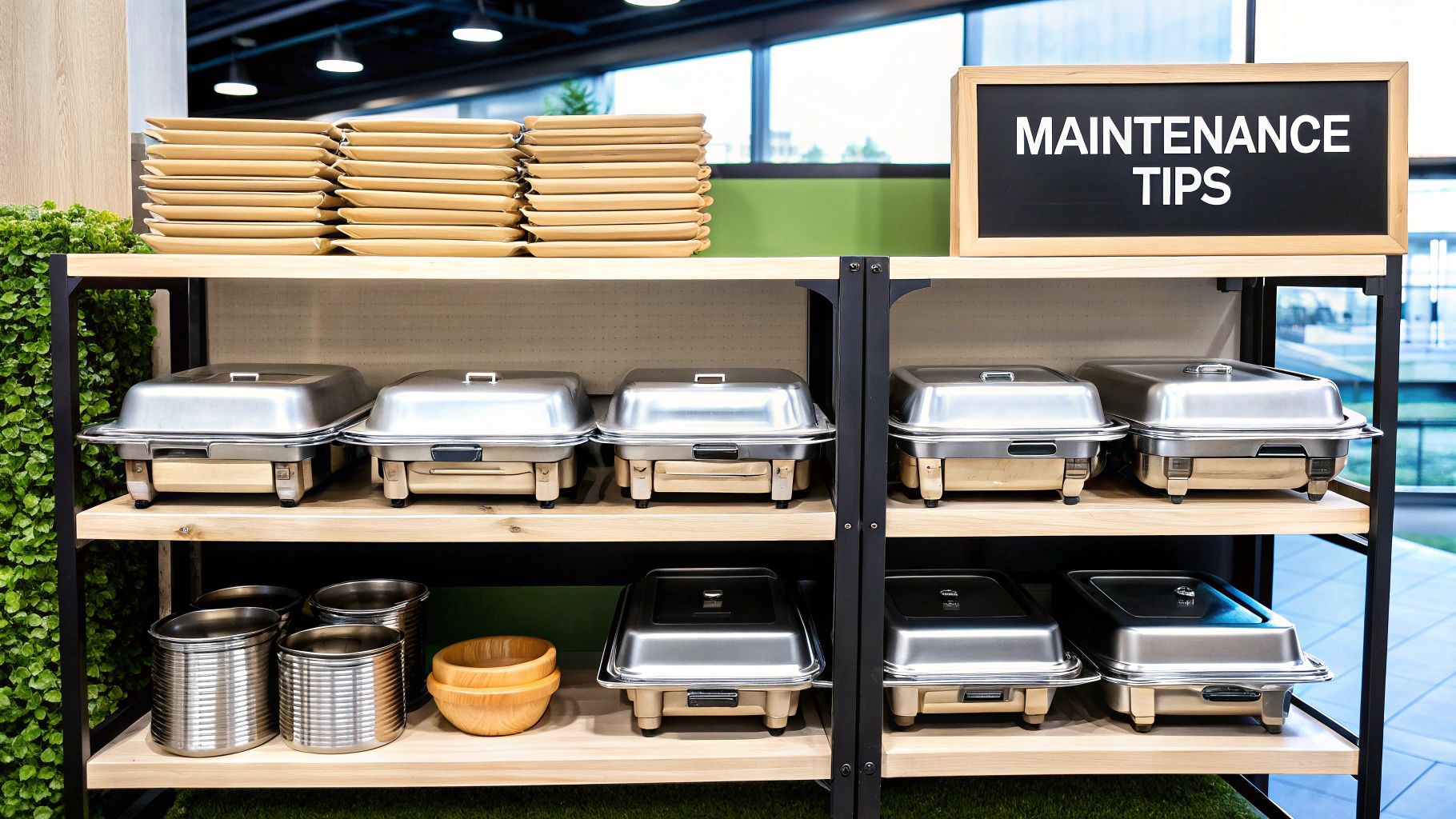
We'll cover everything from portion planning to the technical standards that make all your gear work together. The goal here is to give you practical answers you can use on the fly.
How Many People Does a Full-Size Chafer Serve?
This is the big one, the question that directly impacts your food costs and guest satisfaction. A standard 8-quart full-size chafing dish doesn't have a single magic number; it all depends on what you’re serving.
Here’s a reliable rule of thumb I use in the field:
- Main Courses: When it's a hearty entrée like chicken parmesan, pulled pork, or a pasta dish, plan on serving 25 to 35 people.
- Side Dishes: For things like roasted potatoes, green beans, or mac and cheese, you can stretch it a bit further to serve 35 to 40 guests, since portion sizes are naturally smaller.
Remember to consider the whole menu. If you've got a huge spread with a dozen options, guests will take smaller samples of each, so your chafer will go further. But if it’s one of only two or three hot items, you’ll want to stick to the lower end of that estimate.
Can I Use Different Sized Food Pans in One Chafer?
Yes, and you absolutely should! This is one of the best-kept secrets of efficient buffet setup. The entire system is designed to be modular. A standard full-size chafer frame is built to be a versatile base.
With one chafer, you can easily mix and match:
- One full-size pan
- Two half-size pans
- Three third-size pans (sometimes you'll need a simple adapter bar for a snug fit)
This flexibility lets you serve a trio of sauces, a main with two small sides, or a "build-your-own" bar, all from a single heat source. It’s a game-changer for saving table space and creating a more dynamic, interesting buffet line.
This modularity isn't just a convenient feature; it's a strategic tool. It allows a caterer to offer more menu variety with less equipment, directly impacting setup time, transportation costs, and the overall guest experience.
What Is a Gastronorm or GN Pan Size?
If you’ve ever wondered why a pan from one brand fits perfectly in a chafer from another, you can thank the Gastronorm (GN) system. It’s a European sizing standard that has become the global language for professional kitchen equipment.
It all starts with the GN 1/1, which is your full-size pan measuring roughly 20.87 x 12.87 inches. Every other size is just a fraction of that base. A GN 1/2 is literally half the size, and a GN 1/3 is one-third. This beautiful bit of standardization is what allows you to mix and match pans with confidence, knowing they'll fit in your chafers, steam tables, and coolers.
Are Round Chafing Dish Sizes Standardized?
Unfortunately, no. Round and oval chafing dishes are a bit like the wild west compared to their rectangular cousins. While you'll see common capacities like 4 quarts or 6 quarts, the actual diameters and depths can be all over the place between manufacturers.
This usually means the food pans are proprietary—you have to use the pan that came with the chafer. So why use them? Purely for aesthetics. Their elegant curves are perfect for breaking up the straight lines of a buffet and are fantastic for showcasing soups, sauces, or a special feature dish where presentation is key.
Ready to optimize your buffet service with the perfect equipment? At Encore Seattle Restaurant Equipment, we offer a wide range of new and used chafing dishes to fit any event size and budget. Explore our collection to discover exclusive deals and stay on top of the latest trends in restaurant supplies. Find the ideal solutions for your restaurant or catering business at https://encoreseattle.com.
